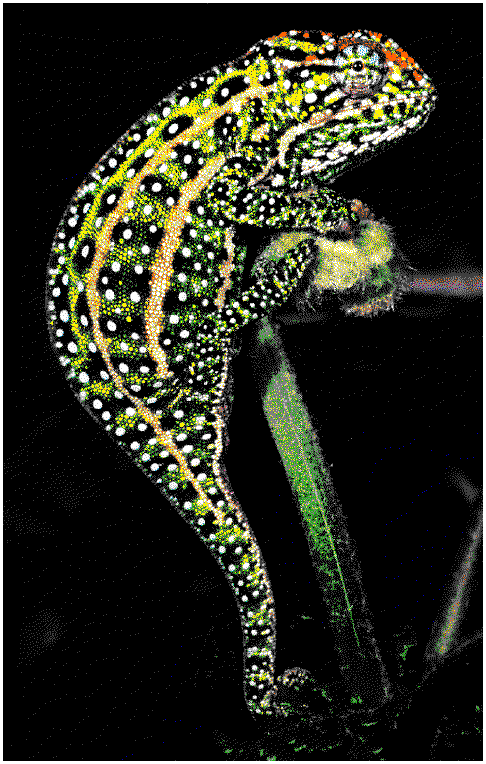Chris Mattison
Nick Garbutt
(Firefly)

Only we were wrong. I find out now so many years after the fact that their color change was (1) an arbitrary random thing, having something to do with mood --- they are moody little rapscallions --- and (2) the fact that they weren't even chameleons (they were anoles).
Chameleons, at least those on display in this colorful book, are not sleek and long and aerodynamically perfect like anoles, but rather clunky little monsters with horns and prognathous jaws and bizarre colors and curled up tails and certainly didn't live where I grew up in the southern United States but made their homes in south and central Africa, near the Mediterranean, the Middle East, Sri Lanka and Madagascar.
If you have a an odd longing for weird and colorful crawly things, you should get this book and immediately book yourself a flight to Madagascar and be prepared to be cooked during the day and rained on in the late afternoon and early evening. The annual rainfall chart at Wikipedia says that it rains 250 - 300 inches during December - February in Antananarivo the capital but I left my reading specs at home and I may be looking at figures for other parts of the island or even other parts of the world or possibly the figures are in centimeters not inches.
Anyway you are not going there to worry about getting wet but to see these horned beasts that were invented about 100 million years ago in the Weird World Animal Factory. The most singular characteristic of chameleons is the ability to move the eyes up and down and around completely independently of each other, as the authors have it, like "a rotating gun turret." This independent action means they may be spying on you at the same moment they are focusing on their favorite foods, which can include mites, termites, springtails, small ants and "first or second instar larvae" whatever that is.
They are also fond of lizards, grasshoppers, locusts, beetles and (no!) beautiful butterflies. Some eat small birds and mice (hooray!) and of course, being coarse and uncivilized (and hungry), other chameleons. The exception is Jackson's chameleon who turns out to be a fruitarian. Like my anoles, they can change color so if you tell them to "turn blue" they can do so at once. This is known as "gravid coloration" and is useful during breeding. The female also can turn dun-colored after penetration, which means she is no longer sexy to the male chameleons.
The foundlings that result are as ugly as sin and in one case --- the Furcifer labordi --- have a quick breeding cycle: they reach sexual maturity three months after hatching.
I have always been fond of the funny eyes of these creatures that rotate separately, but this book says I should also be fond of their tongues. The adult can have tongues approximately one-and-a-half-times as long as they are. The authors tell us that there has been intensive study of chameleon tongues to figure out why at least 90% of the time they can accurately zap their chosen grasshopper, locust, or beetle. It has to do with musculature and the fact that their tongues are equipped with an organic, home-made Bondo.
Most of the creatures pictured here --- and there are over 100 wonderful shots --- are pretty startling. My faves are the "flap-necked chameleon" which looks like my Uncle Fred with his colorful dewlaps and wens and the Trioceros hoennelii which looks like Donald Trump when he is contemplating the prez's birthplace.